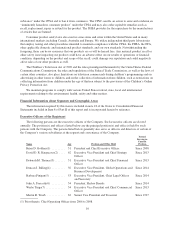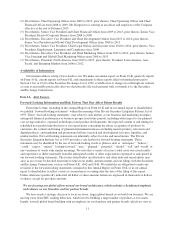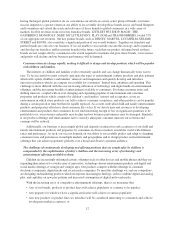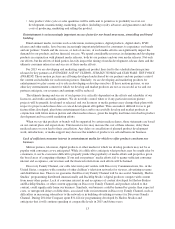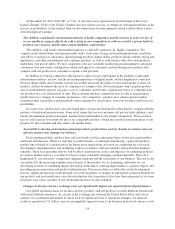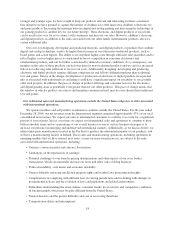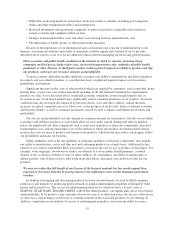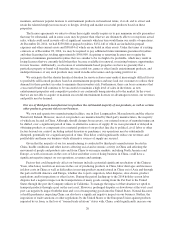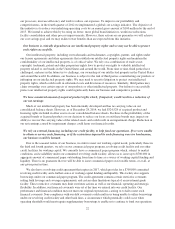Hasbro 2014 Annual Report Download - page 28
Download and view the complete annual report
Please find page 28 of the 2014 Hasbro annual report below. You can navigate through the pages in the report by either clicking on the pages listed below, or by using the keyword search tool below to find specific information within the annual report.At December 28, 2014, $244,587, or 5.4%, of our total assets, represented our investment in Discovery
Family Channel. If Discovery Family Channel does not achieve success, or if there are subsequent declines in the
success or profitability of the channel, then our investment may become impaired, which could result in a write-
down through net earnings.
The children’s and family entertainment industry is highly competitive and the barriers to entry are low. If
we are unable to compete effectively with existing or new competitors or with our retailer’s private label toy
products our revenues, market share and profitability could decline.
The children’s and family entertainment industry is, and will continue to be, highly competitive. We
compete in the United States and internationally with a wide array of large and small manufacturers, marketers,
and sellers of analog toys and games, digital gaming products, digital media, products which combine analog and
digital play, and other entertainment and consumer products, as well as with retailers who offer such products
under their own private labels. We face competitors who are constantly monitoring and attempting to anticipate
consumer tastes and trends, seeking ideas which will appeal to consumers and introducing new products that
compete with our products for consumer acceptance and purchase.
In addition to existing competitors, the barriers to entry for new participants in the children’s and family
entertainment industry are low, and the increasing importance of digital media, and the heightened connection
between digital media and consumer interest, has further increased the ability for new participants to enter our
markets, and has broadened the array of companies we compete with. New participants with a popular product
idea or entertainment property can gain access to consumers and become a significant source of competition for
our products in a very short period of time. These existing and new competitors may be able to respond more
rapidly than us to changes in consumer preferences. Our competitors’ products may achieve greater market
acceptance than our products and potentially reduce demand for our products, lower our revenues and lower our
profitability.
In recent years, retailers have also developed their own private-label products that directly compete with the
products of traditional manufacturers. Some retail chains that are our customers sell private-label children’s and
family entertainment products designed, manufactured and branded by the retailers themselves. These products
may be sold at prices lower than our prices for comparable products, which may result in lower purchases of our
products by these retailers and may reduce our market share.
An inability to develop and introduce planned products, product lines and new brands in a timely and cost-
effective manner may damage our business.
In developing products, product lines and new brands we have anticipated dates for the associated product
and brand introductions. When we state that we will introduce, or anticipate introducing, a particular product,
product line or brand at a certain time in the future those expectations are based on completing the associated
development, implementation, and marketing work in accordance with our currently anticipated development
schedule. There is no guarantee that we will be able to manufacture, source and ship new or continuing products
in a timely manner and on a cost-effective basis to meet constantly changing consumer demands. This risk is
heightened by our customers’ compressed shipping schedules and the seasonality of our business. The risk is also
exacerbated by the increasing sophistication of many of the products we are designing, and brands we are
developing in terms of combining digital and analog technologies, utilizing digital media to a greater degree, and
providing greater innovation and product differentiation. Unforeseen delays or difficulties in the development
process, significant increases in the planned cost of development, or changes in anticipated consumer demand for
our products and new brands may cause the introduction date for products to be later than anticipated or, in some
situations, may cause a product or new brand introduction to be discontinued.
Changes in foreign currency exchange rates can significantly impact our reported financial performance.
Our global operations mean we produce and buy products, and sell products, in many different jurisdictions
with many different currencies. As a result, if the exchange rate between the United States dollar and a local
currency for an international market in which we have significant sales or operations changes, our financial
results as reported in U.S. dollars, may be meaningfully impacted even if our business in the local currency is not
14








